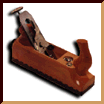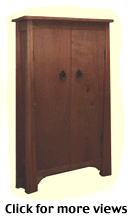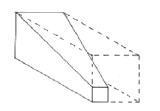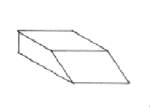 |
|
|
DVD / Blu-ray / CD Cabinet

There are two schools of thought when it comes to storing your CDs. The first school is based on the idea that CDs are something that should be displayed while the second school says that CDs should be hidden away - to be brought out only when choosing the next musical choice. I'm a believer in the latter school and so I created this CD cabinet. The underlying design idea was to make a mission-style cabinet which can form part of the core furnishings in a living room (and holds over 200 CDs). In the coming months we'll be adding to this by including a TV cabinet design, a side table and possibly a lamp.
Construction
Tools required: saw, router, sander, drill
Wood required: Cherry
| Description | Qty | Width | Thickness | Length |
| Front legs | 2 | 2 1/2" | 1 3/4" | 40" |
| Rear legs | 2 | 2 1/2" | 3/4" | 40" |
| Doors | 2 | 9" | 1/2" | 33" |
| Strengthening bar | 2 | 1 1/2" | 1/2" | 8" |
| Front top band | 1 | 2" | 3/4" | 18" |
| Front base band | 1 | 3 1/2" | 3/4" | 18" |
| Side top band | 2 | 2" | 3/4" | 6 1/2" |
| Side base band | 2 | 2" | 3/4" | 6 1/2" |
| Side panel | 2 | 6 1/2" | 1/2" | 32 3/4" |
| Rear top band | 1 | 2" | 3/4" | 18" |
| Rear base band | 1 | 2" | 3/4" | 18" |
| Rear panel | 1 | 19" | 1/4" | 33 1/2" |
| Top | 1 | 10" | 3/4" | 22" |
| Shelves | 5 | 7" | 1/2" | 18" |
| Shelf ledges | 8 | 1/4" | 1/4" | 7" |

The first step (and most complex) is cutting the front legs to shape. The front legs are cut from a block of cherry that is 2 1/2" x 1 3/4" in profile and 40" long. Firstly, nominate two adjoining sides to be the inner sides (one will face back while the other will have the door attached to it). Then, mark out the sloping cut on the side profile and cut this using a circular saw (or preferably a table saw). When this is done, mark out the second slope and also cut this.
The end result is a leg that is 2 1/2" x 1 3/4" at the base and 7/8" x 7/8" at the top (see diagram). Repeat the above steps to make the second front leg, but ensure that the second front leg is a mirror image of the first. Once these legs are cut to shape, plane them (if necessary) to make sure they are even and then sand.
Next, cut the rear legs to shape. The rear legs should match the profile of the front legs as seen from the front (i.e. the angled slop in from the side) but do not have a front to back slope. Because of this, there is only one cut needed for each leg and the result should be a leg that is 2 1/2" x 3/4" at the bottom and 7/8" x 3/4" at the top.
Once you have cut the rear legs to shape, nominate a front and back for each leg. Then, rout out a 1/4" deep groove that is 1/2" wide down the vertical slope of the back of each leg (i.e. the side that is closest to the center). This groove will accommodate the rear plywood panel when it is time to put everything together later.

Take the side bands (both top and bottom) and rout a 1/2" deep groove that is 1/4" wide in the inside of each one (see diagram). Note the side that has the groove in it will be the inside that points towards the center; in other words, for the top band pieces, the groove will face the bottom inside and for the bottom bands, the groove will face the top inside of the band. This groove will accommodate the side panels.
You can now glue the top and bottom bands to the side panel to form a solid side panel. The result should be a flush fit on the inside of the unified panel, with the top and bottom bands jutting out 1/4" on the outer side of the panel.

Now that the side panels are constructed, cut the front top and base bands to shape. The front top band should have a 1/4" deep, 1/4" wide groove cut out of the lower outside edge. This will provide a ledge for the door to rest against. The bottom front band is more complex. Rather than having a simple straight piece, I went for a more stylish design (see diagram). However, if this is not to your taste this is an ideal way to differentiate the design somewhat and a straight-lined, jagged look would work very well. Again, whatever shape you opt for, you should rout out a 1/4" deep, 1/4" wide groove in the top front side of it to act as a door ledge.
The back two bands are far more basic (after all, you can't see them!). Cut out a groove that is 1/4" deep and 1/2" wide out of the back side of each one to allow the plywood rear panel to overlap.
Now it is time to begin the construction. Note that unless otherwise stated, all joints are simple glued dowel joints requiring nothing more complicated than the ability to drill a hole (see joints section for more details). Attach the front top and bottom bands to the two front legs to form the front frame. The base band should be attached so that the top of it is 34 5/8" from the top of the leg. Then attach the rear top and bottom bands to the rear legs to form the rear frame. Add the rear plywood panel at this time (by gluing and nailing from the back). Make sure that the good side of the plywood will face the front, not the back). The profile of both front and back frames should be identical.
While waiting for these frame to dry, attach the shelving ledges into place. These should be fitted at even intervals up the height of the side panels (naturally on the inside of each panel). Note that there must be at least 5" between each shelf in order to allow for a CD, although I would recommend 6" which provides for a less cramped look. Attach these ledges using small nails and glue.
Once the front and back constructions are glued solid it is time to add the side panels, thus forming a solid unit. At the same time that you add the side panels you must also add the bottom shelf. This bottom shelf should sit flush with the top of the front base band and should also by attached using dowels. Practice dry-fitting the sides, base, front and back before applying glue to make sure you have it all fitting correctly. Clamp overnight.
Once the construction is dry attach the top -- again, using dowel joints.
Before attaching the doors, cut a 1/4" deep, 1/4" wide groove in the top and bottom of each one. The side that you cut these grooves into will become the inside of the door panel. This groove should match up with the top and bottom band grooves, thus allowing the doors to close snuggly.

To finish off the doors, attach the door strengthening bar to each door. This is to help stop the doors (which are quite thin) from warping too easily. This bar should be glued onto the inside of each door panel at a height of 9 1/4" from the top of the door. Further, this panel also provides a stronger place to attach the door pull into. Note that the door strengthening bars should have mitered edges, rather than being cut straight at a 90 degree angle as you would usual (see diagram).

To attach the doors to the unit, use offset hinges (see diagram). These mean that you do not need to make insets for the hinges and, further, will allow for the fact that the hinges must fit tightly against the front legs.
Finally, sand the unit down, wax it and add door pulls to suit your taste.